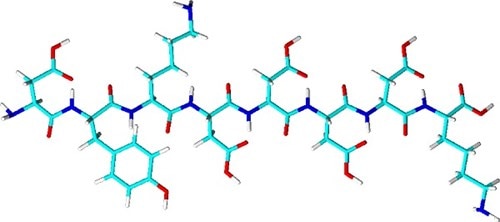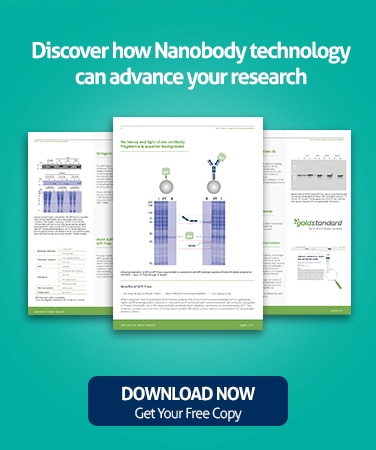Flag-tag and 3x Flag-tag
Overview about specifications, properties, origin, sequence, size, specifications, etc. of Flag-tag
- What is Flag-Tag?
- How does Flag-tag work?
- Structure of Flag-tag
- Development and discovery of Flag-tag
- Properties
- How to Flag-tag a protein?
- Size of Flag-tag and 3x Flag-tag
- Specifications of the Flag-tag and 3x Flag-tag
- Flag-tag epitope tag sequences
- When should I use 3x Flag and when should I use 1x-Flag-tag?
- Why is Flag-tag also called DYKDDDDK-tag?
- Applications
- Flag- vs. Myc-tag
- Flag- vs. HA-tag
- Flag- vs. Spot-tag
- Flag- vs. V5-tag
- How to elute Flag-tagged proteins?
- Flag-tag plasmids
- What anti-Flag-tag antibodies are available, what anti-DYKDDDDK antibodies are available?
- Request your DYKDDDDK Fab-Trap sample for superior immunoprecipitation here
1. What is Flag-tag?
Flag-tag is a commonly used epitope or peptide tag that is not derived from a natural protein. The Flag-tag is an artificial tag and, based on the peptide sequence, is also called DYKDDDDK-tag. Flag-tag is used to tag proteins for multiple capture and detection applications.
2. How does Flag-tag work?
Flag-tagged proteins are investigated using anti-Flag antibodies, which bind to the tag.
The Flag-tag is either N- or C-terminally cloned to the protein of interest. After expression, the recombinant Flag-tag fusion protein can be analyzed by means of ELISA, flow cytometry, immunofluorescence (IF), immunoprecipitation (IP) & co-immunoprecipitation (Co-IP), protein purification, and Western blotting (WB).
3. Structure of Flag-tag

Structure of the Flag-tag octapeptide
4. Development and discovery of Flag-tag
The Flag-tag was first described by Hopp et al. (1988)*.
5. Properties
The Flag-tag contains 8 amino acids (aa) and has the sequence motif NH2-DYKDDDDK-COOH (Asp-Tyr-Lys-Asp-. Asp-Asp-Asp-Lys). The sequence contains an enterokinase cleavage site (DDDDK). Cleavage by enterokinase removes the Flag-tag from the Flag-tagged protein. In addition to 1x Flag-tag , 3x Flag-tag is also commonly used. The most frequently used sequence motif is not a simple repetition of the 1x Flag sequence: DYKDHDG-DYKDHDI-DYKDDDDK.
6. How to Flag-tag a protein?
Like other protein and peptide tags, Flag-tag is attached to a protein of interest (POI). Normally, the Flag-tag is cloned in frame to the POI in a DNA plasmid. The recombinant DNA plasmid is then used for transfection.
7. Size of Flag-tag and 3x Flag-tag
Flag-tag
Number of amino acids: 8
Molecular weight (MW): 1012.98 Da
3x Flag-tag
Number of amino acids: 22
Molecular weight (MW): 2730.71 Da
8. Specifications of the Flag-tag and 3x Flag-tag
Flag-tag
Theoretical isoelectric point (pI): 3.97, which reflects the high degree of negatively charged amino acid residues. With a total of seven charged amino acids, the Flag-tag is highly charged.
Total number of negatively charged residues (Asp + Glu): 5.
Total number of positively charged residues (Arg + Lys): 2.
Total number of charged residues: 7.
3x Flag-tag
Theoretical pI: 4.16
Total number of negatively charged residues (Asp + Glu): 11.
Total number of positively charged residues (Arg + Lys): 4.
Total number of charged residues: 15.
9. Flag-tag epitope tag sequences
Flag-tag
Flag-tag amino acid sequence:
DYKDDDDK
Flag-tag DNA sequence:
GAC TAC AAG GAC GAC GAT GAC AAG
3x Flag-tag
3x Flag-tag amino acid sequence:
DYKDHD-G-DYKDHD-I-DYKDDDDK
3x Flag-tag amino acid sequence:
GAC TAC AAG GAC CAC GAC GGT GAC TAC AAG GAC CAC GAC ATC GAC TAC AAG GAC GAC GAC GAC AAG TGA
D=Aspartic acid; G=Glycine; H=Histidine; I= Isoleucine; K=Lysine; Y=Tyrosine
10. When should I use 3x Flag and when should I use 1x-Flag-tag?
There is no simple answer to this question. The increased length of the 3x Flag-tag increases the affinity of the anti-Flag antibody/affinity reagents. 3x Flag-tag is often used in tandem purification and protein purification. As mentioned above, 3x-Flag-tag is longer than 1x Flag-tag and has more charged amino acids. Negatively and positively charged amino acids potentially interfere more strongly with the POI and may influence protein expression.
For detection in Western blot, 1x Flag-tag should be sufficient.
11. Why is Flag-tag also called DYKDDDDK-tag?
FLAG is a registered trademark of Sigma-Aldrich Co. LLC. Other suppliers may refer to the Flag-tag as DYKDDDDK-tag instead.
12. Applications
While the Flag-tag has been developed as a capture tag for IP and protein purification, and for immunoblotting, it is also used for immunofluorescence.
13. Flag- vs. Myc-tag
Comparison of Flag-tag and Myc-tag
| Flag-tag | Myc-tag | |
| Origin | - | human c-Myc |
| 3D structure |  |
 |
| Amino acid sequence | DYKDDDDK | EQKLISEEDL |
| Number of amino acids | 8 | 10 |
| Molecular weight (in Da) | 1012.98 | 1203.31 |
| Theoretical isoelectric point (pI) | 3.97 | 4.00 |
| Total number of negatively charged residues (Asp + Glu) | 5 | 4 |
| Total number of positively charged residues (Arg + Lys) | 2 | 1 |
14. Flag- vs. HA-tag
Comparison of Flag-tag and HA-tag
| Flag-tag | HA-tag | |
| Origin | - | Human influenza hemagglutinin (HA) is derived from human influenza virus |
| 3D structure |  |
 |
| Amino acid sequence | DYKDDDDK | YPYDVPDYA |
| Number of amino acids | 8 | 9 |
| Molecular weight (in Da) | 1012.98 | 1102.17 |
| Theoretical isoelectric point (pI) | 3.97 | 3.56 |
| Total number of negatively charged residues (Asp + Glu) | 5 | 2 |
| Total number of positively charged residues (Arg + Lys) | 2 | 0 |
15. Flag- vs. Spot-tag
Comparison of Flag-tag and Spot-Tag
| Flag-tag | Spot-tag | |
| Origin | - | Derived from human beta-catenin |
| 3D structure |  |
 |
| Amino acid sequence | DYKDDDDK | PDRVRAVSHWSS |
| Number of amino acids | 8 | 12 |
| Molecular weight (in Da) | 1012.98 | 1396.53 |
| Theoretical isoelectric point (pI) | 3.97 | 10.03 |
| Total number of negatively charged residues (Asp + Glu) | 5 | 1 |
| Total number of positively charged residues (Arg + Lys) | 2 | 2 |
16. Flag- vs. V5-tag
Comparison of Flag-tag and V5-tag
| Flag-tag | V5-tag | |
| Origin | - | P and V protein of the simian virus 5 |
| 3D structure |  |
 |
| Amino acid sequence | DYKDDDDK | GKPIPNPLLGLDST |
| Number of amino acids | 8 | 14 |
| Molecular weight (in Da) | 1012.98 | 1421.66 |
| Theoretical isoelectric point (pI) | 3.97 | 5.84 |
| Total number of negatively charged residues (Asp + Glu) | 5 | 1 |
| Total number of positively charged residues (Arg + Lys) | 2 | 1 |
17. How to elute Flag-tagged proteins?
Flag-tag fusion proteins can be eluted by
- Competitive elution with Flag peptides: 1x Flag peptide or 3x Flag peptide.
Please note that 1x Flag peptide will not elute 3x Flag-tagged proteins - Acidic elution with glycine (pH2.5)
- SDS sample buffer
18. Flag-tag plasmids
Vectors for expression of Flag-tag containing a multiple cloning site (MCS) for mammalian cells, Drosophila, etc. are available from many suppliers including Merck (Sigma Aldrich) and Novus Biologicals. Addgene is also a source.
19. What anti-Flag-tag antibodies are available, what anti-DYKDDDDK antibodies are available?
Recombinant, monoclonal, and polyclonal anti-Flag antibodies are available from multiple suppliers. ChromoTek offers a ready-to-use DYKDDDDK Fab-Trap™ for efficient and high-purity immunoprecipitation of Flag-tagged proteins.
Proteintech offers self-manufactured anti-Flag antibodies that have been validated for different applications including immunofluorescence (IF), immunoprecipitation (IP), ELISA, and Western blotting (WB):
Recombinant antibodies: DYKDDDDK tag Recombinant antibody
Monoclonal antibodies: DYKDDDDK tag Monoclonal antibody
Polyclonal antibodies: DYKDDDDK tag Polyclonal antibody
20. Request your DYKDDDDK Fab-Trap sample for superior immunoprecipitation
Improve your immunoprecipitation results with the DYKDDDDK Fab-Trap. Request a free DYKDDDDK Fab-Trap Agarose test sample here:
* Hopp, T., Prickett, K., Price, V. et al. A Short Polypeptide Marker Sequence Useful for Recombinant Protein Identification and Purification. Nat Biotechnol 6, 1204–1210 (1988). https://doi.org/10.1038/nbt1088-1204
Related Content
How to immunoprecipitate Flag®-tagged proteins
Why is the Fab-Trap™ so Fab-ulous?
Advantages and limitations of different antibody formats in immunoprecipitation
Learn how to save precious hours on your IP, IF, and western blotting experiments
Support
Request a Free Nano-Trap Sample
Nano-Trap system provides fast, reliable, and effective immunoprecipitation of fusion proteins. More than 3,000 peer-reviewed articles have already been published using ChromoTek's Nano-Traps.
